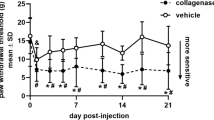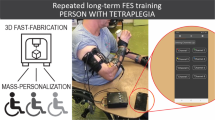Abstract
Nineteen adolescent subjects with complete spinal cord injuries resulting in paraplegia or tetraplegia participated in a functional electrical stimulation (FES) program consisting of computerized, controlled exercise and/or weight bearing. The effects of stimulated exercise and standing/ walking on the lower extremity joints were prospectively studied. Plain radiographs and MRIs were obtained prior to and following completion of the exercise and standing and walking stages. In addition, the joints of five subjects were studied with synovial biopsies, arthroscopy, and the analysis of serum and synovial fluid for a 550 000 dalton cartilage matrix glycoprotein (CMGP). Pre-exercise joint abnormalities secondary to the spinal cord injury improved following the stimulation program. None of the subjects developed Charcot joint changes. Upon standing with FES, one subject with poor hip coverage prior to participation developed hip subluxation which required surgical repair. No other detrimental clinical effects occured in the lower extremity joints of subjects participating in an FES program over a 1-year period.
Similar content being viewed by others
Log in or create a free account to read this content
Gain free access to this article, as well as selected content from this journal and more on nature.com
or
References
Enneking W F, Horowitz M . The intra-articular effect of immobilization on the human knee. J Bone and Joint Surg 1972: 54A: 973–965.
Akeson W H, Amiel D, Abel M F, Garfin S, Woo S . Effects of immobilization on joints. Clin Orthop 1987; 219: 28–36.
Palmoski M, Perricone E, Brandt K D . Development and reversal of a proteoglycan aggregation defect in normal canine knee cartilage after immobilization. Arthr and Rheum 1979; 22(5): 508–517.
Salter R B, Simmonds D F, Malcolm B W, et al. The biological effect of continuous passive motion on the healing of full-thickness defects in articular cartilage. An experimental investigation in the rabbit. J Bone and Joint Surg 1980: 62A: 1232–1251.
Palmoski M J, Colyer R A, Brandt K D . Joint motion in the absence of normal loading does not maintain normal articular cartilage. Arthr and Rheum 1980; 23(3): 325–334.
Palmoski M J, Brandt K D . Running inhibits the reversal of atrophic changes in the canine knee cartilage after removal of a leg cast. Arthr and Rheum 1981; 24(11): 1329–1337.
Jarvelin J, Kiviranta I, Saamanen A M, Tammi M, Helminen H J . Partial restoration of immobilization-induced softening of canine articular cartilage after remobilization of the knee (stifle) joint. J Orthop Res 1989; 7: 352–358.
Katz I, Rabinowitz J G, Dziadiw R . Early changes in Charcot's joints. Am J Roentgenol 1961; 86: 965–974.
Marsolais E B, Kobetic R . Functional electrical stimulation for walking in paraplegia. J Bone and Joint Surg 1987; 69A: 728–733
Smith B T, Betz R R, Mulcahey M J, Triolo R J . Reliability of percutaneous intramuscular electrodes for upper extremity functional neuromuscular stimulation in adolescents with C5 tetraplegia. Arch Phys Med Rehabil 1994; 75: 939–945.
Triolo R J, Kobetic R, Betz R R (in press) Standing and Walking with FNS: Technical and Clinical Challenges. In: Harris G, editor. Human Motion Analysis. New York (In press).
Thomasson J L, Sundaram M . The diabetic foot. Radiographic appearances. Orthopedics 1985; 8(5): 670–676.
Sabiston C P, Adams M E, Li D K B . MRI of osteoarthrosis: correlation with gross pathology using an experimental model. J Orthop Res 1987; 5: 164–172.
Crues J V III, Ryu R . MRI of the knee. Surg Rounds Orthop., 1989.
Fife R S, Brandt K D . Identification of a high-molecular weight (>400 000) protein in hyaline cartilage. Biochem Biophys Acta 1984; 802: 506–514.
Fife R S . Identification of link proteins and a 116 000-dalton matrix protein in canine meniscal cartilage. Arch Biochem Biophys 1985; 240: 682–688.
Fife R S, Palmoski M J, Brandt K D . Metabolism of a cartilage matrix glycoprotein by normal and osteoarthritic canine articular cartilage. Arthritis Rheum 1986; 29: 1256–1262.
Fife R S, Brandt K D . Cartilage matrix glycoprotein is present in serum in experimental canine osteoarthritis. J Clin Invest 1989; 84: 1432–1439.
Fife R S . Identification of cartilage matrix glycoprotein in synovial fluid in human osteoarthritis. Arthritis Rheum 1988; 31: 553–556.
Fife R S, Rachow J W, Ryan L M . Cartilage matrix glycoprotein in plasma and synovial fluids: retention in synovial fluids containing basic calcium phosphate crystals. Calcif Tis Int 1994; 55: 100–102.
Betz R R, Triolo R J, Hermida V M, Moynahan M, Gardner E R, Maurer A, Cook S D, Bennett J T . (1991) The effects of functional neuromuscular stimulation on the bone mineral content in the lower limbs of spinal cord injured children. American Spinal Injury Association annual meeting, Seattle.
Giove T P, Miller S J 3d, Kent B E, Sanford T L, Garrick J G . Non-operative treatment of the torn anterior cruciate ligament. J Bone and Joint Surg 1983: 65A: 184–192.
Pierre-Jacques H, Betz R R, Henzes J (1995). Hip instability in spinal cord injury. Poster exhibit presented at the American Academy of Orthopaedic Surgeons annual meeting, Orlando.
Heinegard D, Saxne T . Connective tissue macromolecules as markers for tissue processes in joint diseases. Eur J Rheumatol Inflamm 1991; 11: 91–99.
Fife R S, Brandt K D, Braunstein E M, Myers S L, Katz B P, Ehlich J, Shelbourne K D, Kalasinski L A . The presence of cartilage matrix glycoprotein in serum as determined by immunolocation analysis is not a sensitive indicator of ‘early' osteoarthritis of the knee. J Lab Clin Med 1991; 117: 332–338.
Fife R S . Imaging, arthroscopy, and ‘markers’. Current Opinion in Rheumatology 4: 560–565.
Johnson J T H . Neuropathic fractures and joint injuries. J Bone and Joint Surg 1967: 49A: 1–30.
Browner A C, Almiar R M . Pathogenesis of the neuropathic joint: Neurotraumatic vs. neurovascular. Radiology 1981; 139: 349–354.
Author information
Authors and Affiliations
Rights and permissions
About this article
Cite this article
Betz, R., Boden, B., Triólo, R. et al. Effects of functional electrical stimulation on the joints of adolescents with spinal cord injury. Spinal Cord 34, 127–136 (1996). https://doi.org/10.1038/sc.1996.25
Issue date:
DOI: https://doi.org/10.1038/sc.1996.25



